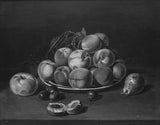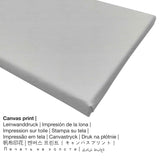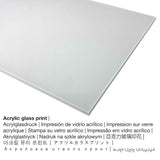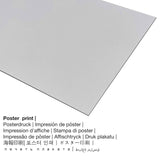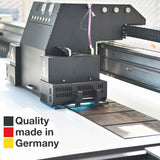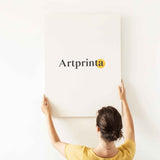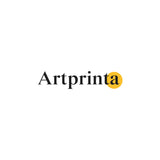John A. Woodside, 1825 - Ntụkwasị Ndụ: Peaches, Apple, na Pear - ọmarịcha nka.
Ụtụ gụnyere. Mbupu gbakọrọ na ndenye ọpụpụ.
Ozi ngwaahịa nka zuru ezu
Nke a gafee 190 year-old artpiece was created by the artist John A. Woodside in 1825. The masterpiece was made with the size: 9 3/4 x 12 1/4 na (24,8 x 31,1 cm) ma jiri usoro ihe arụpụtara ya mmanụ n'elu osisi. N'oge a, ihe osise a bụ nke nchịkọta Museumlọ ihe ngosi nka nke Obodo. Site n'ikike nke Ụlọ ihe ngosi nka nke Metropolitan, New York, Rogers Fund, 1941 (ikikere - ngalaba ọha). Tụkwasị na nke ahụ, ihe nkiri ahụ nwere kreditline: Rogers Fund, 1941. Kedu ihe ọzọ, nhazi ahụ bụ odida obodo ya na oke nke 4: 3, nke pụtara na ogologo bụ 33% ogologo karịa obosara.
Họrọ ụdị ebipụta nka nka
Maka mbipụta nka ọ bụla anyị na-enye ụdị nha & ihe dị iche iche. N'ihi ya, anyị na-enye gị ohere ịhọrọ n'ime nhọrọ ndị a:
- Mbipụta akwụkwọ mmado (ihe kwaaji): The Artprinta poster print is a printed canvas with a fine surface finish. A printed poster is particularly qualified for putting your art replica using a custom-made frame. Please bear in mind, that depending on the absolute size of the poster print we add a white margin of approximately 2-6 cm round about the print, which facilitates the framing with your custom frame.
- Mbipụta nke aluminom: These are metal prints on aluminium dibond material with an outstanding effect of depth. The Aluminium Dibond Print is the excellent introduction to art replicas with aluminum. The print on Aluminum Dibond is one of the most demanded entry-level products and is an extremely modern way to display fine art reproductions, since it puts 100% of the viewer’s focus on the replica of the artwork.
- Mbipụta iko acrylic (nke nwere ezigbo mkpuchi iko): A glossy print on acrylic glass, which is often described as a plexiglass print, changes the original work of art into amazing décor and is a good alternative to aluminium or canvas art prints. Your favorite artwork is being made thanks to modern UV direct print technology. The real glass coating protects your custom art print against sunlight and external influences for several decades.
- Mbipụta kwaaji: The UV printed canvas mounted on a wooden stretcher frame. A canvas makes the sculptural effect of three dimensionality. A canvas print has the advantage of being relatively low in weight, which means that it is easy and straightforward to hang the Canvas print without extra wall-mounts. Hence, canvas prints are suited for all types of walls.
Important legal note: We try all that we can in order to depict the art products as closely as possible and to illustrate them visually. Nevertheless, the pigments of the printed materials and the imprint might vary to a certain extent from the presentation on your screen. Depending on the settings of your screen and the condition of the surface, colors can unfortunately not be printed as exactly as the digital version. Considering that all the fine art prints are printed and processed by hand, there might also be minor deviations in the motif's size and exact position.
Banyere ihe a
| Nkewa ngwaahịa: | nka nka |
| Usoro mmeghari: | dijitalụ mmeputakwa |
| Usoro mmepụta: | Mbipụta UV ozugbo (mbipụta dijitalụ) |
| Nlụpụta: | German mere |
| Stockdị ngwaahịa: | a na-achọ |
| Eji ngwaahịa emebere: | mgbidi ịchọ mma, ime ụlọ |
| Ndepụta: | usoro odida obodo |
| Oke akụkụ onyonyo: | 4: 3 - ( Ogologo: obosara) |
| Oke onyonyo pụtara: | ogologo bụ 33% ogologo karịa obosara |
| Akụrụngwa ị nwere ike ịhọrọ: | Mbipụta kwaaji, mbipụta ọla (aluminium dibond), mbipụta enyo acrylic (nwere ezigbo mkpuchi iko), mbipụta akwụkwọ mmado (akwụkwọ kwaaji) |
| Canvas dị n'elu ihe nrịbama (mbipụta kanvas) nha dị iche iche: | 40x30cm - 16x12" |
| Mbipụta iko acrylic (nwere ezigbo mkpuchi iko) dị iche iche: | 40x30cm - 16x12" |
| Mpempe akwụkwọ mmado (akwụkwọ kwaaji) nha: | 40x30cm - 16x12" |
| Mpempe akwụkwọ Dibọn (ihe alumnium): | 40x30cm - 16x12" |
| Igwe onyonyo: | oyiri nka na-enweghị isi |
Data ndabere na nka pụrụ iche
| Aha eserese: | "Still Life: Peaches, Apple, and Pear" |
| Nhazi nke ihe nka: | sere |
| Nhazi nka: | nkà nke oge a |
| Time: | 19th narị afọ |
| Afọ okike: | 1825 |
| Ogologo afọ nka nka: | 190 afọ |
| Agba na: | mmanụ n'elu osisi |
| Akụkụ nke nka nka izizi: | 9 3/4 x 12 1/4 na (24,8 x 31,1 cm) |
| Ụlọ ihe ngosi nka / ebe: | Museumlọ ihe ngosi nka nke Obodo |
| Ebe ngosi nka: | New York City, New York, Njikota Obodo Amerika |
| Ebe nrụọrụ weebụ ihe ngosi nka: | Museumlọ ihe ngosi nka nke Obodo |
| Ụdị ikike nka: | ngalaba ọha |
| Site n'aka: | Ụlọ ihe ngosi nka nke Metropolitan, New York, Rogers Fund, 1941 |
| Ebe E Si Nweta: | Rogers Fund, 1941 |
Ozi ndabere izugbe gbasara onye na-ese ihe
| Ihe nkiri: | John A. Woodside |
| Aha ndị ọzọ: | John A. Woodside, John Archibald Woodside |
| okike nke onye nka: | nwoke |
| Obodo onye nka: | American |
| Ọrụ nke onye na-ese ihe: | painter, history artist, artist |
| Obodo onye nka: | United States |
| Nkewa onye nka: | omenkà nke oge a |
| Ndụ: | 71 afọ |
| A mụrụ: | 1781 |
| Obodo: | Philadelphia, Philadelphia County, Pennsylvania, Njikota Obodo Amerika |
| Afọ nwụrụ: | 1852 |
| Obodo ọnwụ: | Philadelphia, Philadelphia County, Pennsylvania, Njikota Obodo Amerika |
© Copyright - www.artprinta.com (Artprinta)
Nkọwa zuru oke nke Ụlọ ihe ngosi nka nke Obodo ukwu (© - Ụlọ ihe ngosi nka nke obodo ukwu - Museumlọ ihe ngosi nka nke Obodo)
Woodside probably received his training from Philadelphia sign painter Matthew Pratt or one of Pratt’s business partners. In 1805, Woodside opened his own studio in Philadelphia, advertising his services as an ornamental or sign painter. He aspired to less mundane genres, however, and tried his hand at emblematic and patriotic works, animal scenes, miniatures, and copies after English engravings. This work and its companion, "Still Life: Peaches and Grapes" (41.152.1), are among Woodside’s few known still lifes and represent his best efforts as a painter. His arrangement of the fruit in a spare setting bears the stylistic imprint of the Peale family, who established a still-life tradition in Philadelphia in the early nineteenth century.

